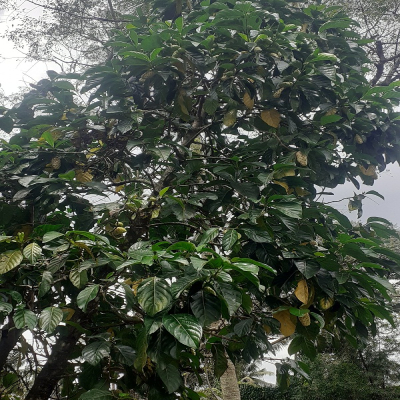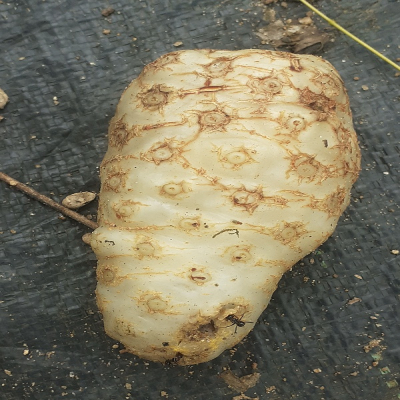Distribution and Habitat: Originated in south-east Asia and to be more specific, in India. In India the plant is growing wild in the coastal areas of Kerala, Karnataka, Tamil Nadu and Orissa. The highest naturally growing populations are seen in Andaman and Nicobar Islands. It is also seen distributed in Hawai. However, M. citrifolia is considered to be an endangered plant and listed in the Red Data Book.
Botany: Noni is perennial and bushy type growing to a height of 2.5-3.5 m with a stem diameter up to 12.0 cmIt is a medium sized tree or bush of about 3-9 m height.
- Leaf: Opposite, pinnately veined, blades membraneous, broadly elliptical, 5-17 cm long, 10-45 cm broad.
- Flowers: Perfect and bisexual. Small tubular white flowers are grouped together and inserted on the peduncle. Calyx tubular, truncated rim, extremely reduced, with small lobes. Corolla white, 5-lobed, the tube greenish white, 7-9 mm long, margin entire, obtuse or acute at the apex. Stamens five, scarcely exserted, alternate to the corolla lobes, shorter than corolla tube, equal, glabrous. Style exserted just beyond the corolla, about 15 mm long, exert. Ovary is inferior; 2 or 4 locular, narrowly obovoid.
- Fruit: Densely clustered globose, syncarp fleshy, yellowish white, about 5-10 cm long and 3-4 cm in diameter, fetid when ripe. Seed posses distinct air chamber, ovoid to obovoid or reniform, viable even after floating in water for months.
Properties: Anti bacterial, antiviral, antifungal, antitumour, antidiabetes, analgesic, anti inflammatory, immunity enhancing.
Uses: For over 2000 years or more, the plant has been identified as a medicinal and wellness plant by Polynesians and Tahitians and they used it for therapeutic uses. Almost all parts of the plant are used for one or other purposes. The fruits are used in food preparations and as medicine, leaves as medicine and for making dyes, stem and roots for preparing dyes and also as firewood.
Agrotechnology:
Climate and soil: Noni is well adapted to tropical climate and a wide range of soils. The plant is highly tolerant to acidic and saline conditions and grows well from a pH range of 4.4 to 9.0.
Propagation: Noni can be propagated through seeds, cuttings and tissue culture. Since, it is a highly cross pollinated plant; there exists lot of variation between plants raised from seedlings. For raising seedlings, the seeds should be collected from fresh ripe fruits and sown in nursery beds. On storage, seeds loose viability in 6-8 months. Even though cuttings can be used for multiplication, they lack commercial productivity. Hence, tissue culture saplings are generally used for planting in commercial gardens.
Planting: The seedlings/ saplings are transplanted to main field when they are around 8 weeks old and sufficiently grown up. Planting is done at a spacing of 2-3 m in pits of size 50 cm3 filled with well decayed organic manure or compost and top soil. Since, noni is a medicinal plant organic farming practices alone are followed.
Aftercare: Regular irrigation and weeding are done for the crop up to 3 years of planting and thereafter irrigation can be reduced.
Harvesting: Flowering starts from 6-10 months after planting. Noni starts giving an economic yield from third year onwards. Since, flowering is continuous in Noni, harvesting also has to be done regularly. The fruits are harvested when fully ripened. The fruits should be harvested with the pedicel intact, since such fruits can be preserved for about 9 days after harvest. The fruits with out pedicel can be stored up to 5 days only. The length of pedicel and the storability of the fruits are positively correlated. Immediately after harvest, the fruits should be sent to the processing units to avoid decay. The fruit weight ranged between 125-150 g and average yield is 5.0 kg/ tree in the common types grown in Andaman & Nicobar Islands. However, high yielding types identified at Central Agricultural Research Institute (CARI), Port Blair, Andaman and Nicobar Islands have given fruit weight up to 200 g and yield of more than 7.0 kg/ tree. The investigations conducted at CARI have shown that the selection, IC-524021 is highly saline tolerant, IC-524022 is highly nutritive and HD-6 giving 164 g fruit weight on an average.
Pests and diseases: A number of insect pests and diseases are recorded in other countries. The diseases recorded on Noni are black flag (Phytophthora sp.) causing blackening and dying of leaves and fruits, anthracrose (Colletotrichum sp.), stem blight (Sclerotium rolfsii), stem canker (Ascomycetes), sooty mould, shot hole, algal leaf spot and post harvest fruit rot (Rhizopus sp.). The root knot nematode, Meloidogyne sp. is reported to cause severe damage to the roots of young noni plants resulting in stunted growth and eventual death. Aphids, thrips, white flies, green scale (Coccus viridis), leaf miner, leaf feeding caterpillar (Achaea janata), soring beetle and giant african snail are the insect pests reported on the plant. However, in India the pest and disease incidence is comparatively low. Diseases like black flag, leaf blight, leaf spot, sooty mould, fruit rot and mosaic virus are reported in the country. Even though around 15 insect pests are found to damage the noni plants, only very few such as morinda lace wing bug (Dulinius conchatus) are causing economic damage.
Crop eco-system based protection should be adopted for the management of pest and diseases in noni. Instead of insecticide applications, plant protection should be done using bio-control agents and botanicals. Plant Growth Promoting Rhizobacteria (PGPR) has great influence in reducing pests and diseases in the plant. Pseudomonas application is found to reduce many of the diseases.



